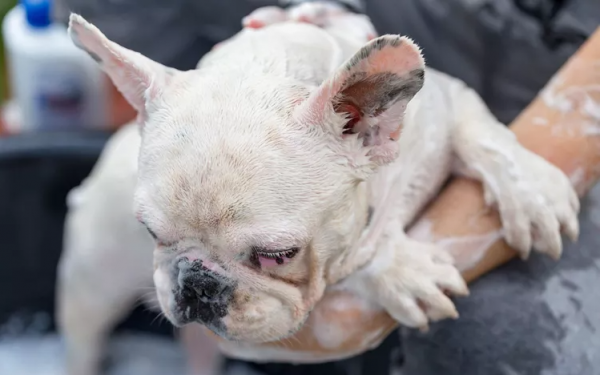If you have a dog, chances are that sooner or later they will have an unfortunate encounter and come home smelling distinctly of skunk. Before you fill your bathtub with all the canned tomatoes in your pantry, step back and take a breath. You’ve got this.
Tomato juice actually does little to help neutralize odors, instead acting as a mask to cover up that familiar skunk-y smell. But there are a few key steps you can take, and a few common household ingredients you can use, to ensure your dog and home are free of that stinky smell before long.
What to Do If Your Dog Got Sprayed by a Skunk
Getting sprayed by a skunk is an unpleasant experience for dogs and owners alike. Most typically, however, no first aid is needed after a dog-skunk encounter. If your dog’s eyes appear red or irritated, flush them with cool water or a dog-safe eye wash product.
Andrew Weissman, VMD, DACVR, co-founder of Radimal, says that, usually, the skunk spray will deter your dog from attacking the skunk, and they will not get into any kind of physical altercation. Remember that a skunk sprays when it feels threatened and is trying to scare that threat—in this case, your dog—away. However, if you are concerned about your dog after an interaction with a skunk, it’s best to consult your veterinarian.

4 Easy Steps to Remove Skunk Smell from Your Dog
Your first instinct when you smell skunk on your dog is probably to get them into a bath immediately. However, it’s worth it to take a step back and make sure you are using the correct products to de-skunk your dog, since washing without the proper tools will only further set the smelly oils into your dog’s fur—and bringing your dog inside may spread the odor throughout your house.
1. Deodorize your dog (with the right stuff).
“It’s an old wives tale that tomato paste gets rid of the smell,” says Weissman, who recommends against using tomato products to mask the smell of skunk. Instead, you want to use something that will actually neutralize and remove the odor. You can purchase over-the-counter cleaners to deodorize your dog if you like. These are convenient and might be handy to have around if your dog is especially prone to interactions with skunks, but they are no more effective than a solution you can make yourself with common household ingredients. In fact, Weissman says the mixture below is “better than anything you can buy at Petsmart.”
DIY skunk deodorizer:
1 quart 3% hydrogen peroxide solution (any stronger could cause irritation)
¼ cup baking soda
1 teaspoon liquid dish soap
Mix these three ingredients together and apply to your dog’s fur, letting the mixture soak in a bit, then rinse thoroughly. Wear rubber gloves to avoid getting the skunk spray on your hands. If your dog has dark fur, be careful not to let the mixture sit for too long, as the hydrogen peroxide could slightly bleach their fur.
This DIY mixture should not be made ahead of time and stored, but is luckily very quick and easy to put together if you have the ingredients on-hand.
2. Wash your dog normally.
Next, give your dog a bath as you normally would, using your regular dog shampoo. Dish soap will also work in a pinch. Towel-dry your dog as thoroughly as you can and allow their fur to air-dry in a warm room so they don’t get chilled.
3. Repeat as necessary.
It may only take one deodorizing session to eliminate the skunk smell from your dog’s fur, or it may take a few washes over time to completely remove it. Continue the two-step washing process as many times as it takes to get your dog smelling sweet again.
4. Deodorize your home and clothes.
As much as you might try to keep the skunk smell out of your home when your dog comes back covered in it, that’s not always possible! If the skunky smell leaked into your home, all is not lost.
Weissman recommends boiling a pot of vinegar to eliminate the odor from your house. At first, he says, the house will smell like vinegar, but once that dissipates, it should smell much better. If you have any skunk smell on your clothes, try tossing ½ cup baking soda in with your regular laundry detergent when you wash them.
How to Prevent Your Dog From Getting Skunked in the Future
The easiest way to handle a skunking is, of course, to avoid those little black-and-white creatures in the first place. While it isn’t possible to completely eliminate the possibility, there are a few steps you can take to make your yard less appealing to skunks and reduce the chances of your dog encountering one.
Closing recycling and trash bins and removing any outside food bowls will provide less temptation for skunks to live around your home. Similarly, if you have fruit trees or bushes, pick up any fallen fruit. And most importantly, always supervise your dog when they’re outside, and avoid going out during peak hours when skunks are most active if you can, such as dawn and dusk.



